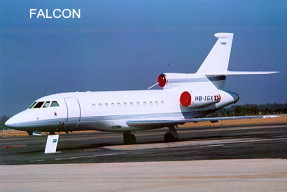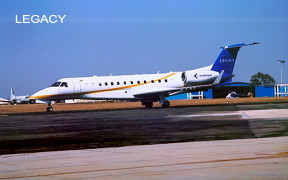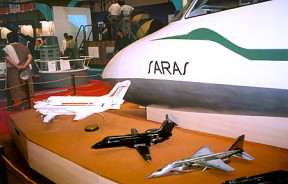|
New Delhi, 26 February 2003
Aero
India 2003
Part
II –– India’s Defence Air Show
By
Ranjit Rai

IL
76 at Aero India 2003
Indian
Defence and Civil Agencies expect to spend over $20 billion on
aviation in the next five years. Some of the on going projects
amounting to almost $4 billion include the SU-30 MK I, Brahmos, MiG
upgrades, MI and Kamov helicopters, ALH and LCA. Therefore anyone
who aspired to be part of the action or was already part of it, had
to show their presence with a Booth, Chalet or attending in person
at “Aero India, 2003” held from 5th to 9th
February. The show was held at Yelahanka, a former British wartime
airfield, now used by IAF for Transport and Helicopter Flying
training.
This
year the show was almost one-third the size of Asian Aerospace,
Asia’s premier show held bi annually at Singapore, which is due to
be held again in 2004. The only difference is that the larger show
at Singapore includes civil aviation agencies, airport services and
several airlines take part along with Space agencies. In the case of
Aero India 2003 however, civilian agencies were conspicuous by their
absence. Many attributed it to the confusion that prevails in the
privatisation and expansion plans of Air India and Indian Air Lines,
and even the Minister of Civil Aviation did not attend.
The
Department of Defence Production and Supplies, Ministry of Defence
in association with the Defence Research and Development
Organisation (DRDO), Indian Air Force and Hindustan Aeronautics Ltd
organised the show, which attracted foreigners and PSUs to take
part. Media reported the MOD had advanced Rs 8 crores for the show.
Profit has never been a motive for MOD and the "show balance
sheet" is never made public. The show was a great success since
the Armed Forces (IAF and DGQA) and HAL, which are resource rich
agencies, conducted the Exposition. Every one was full of praise for
the arrangements and the hospitality including the spirits offered.
They were as Indian hospitality is –– warm and generous. The
bonhomie left the media and the guests in good humour and in some
cases the effects could be seen the next day, a confirmation that it
was a good show. The Air Chief camped at Bangalore before the show
and took pains to see all arrangements were checked out.
The
fillip to the show came partly from the Indian Space Research
Organisation (ISRO), and India’s Defence Budget of over $14 .7
billion which has large allocations for aviation. Generous advances
had been made by the Armed Forces to Hindustan Aircraft Ltd (HAL), which
is cash rich and full of orders.
 Foreign
and Indian participants occupied a total of 8572 sq m of indoor
space and 1874 sq m of outdoor space. 176 international companies
and sub companies from 22 countries (Belarus, Belgium, Brazil,
Canada, Czech Republic, France, Germany, Italy, Israel, Malaysia,
Netherlands, Poland, Romania, Russia, Singapore, South Africa,
Switzerland, Thailand, Ukraine Republic, UK and USA) and 75 Indian
Companies participated in Aero India 2003. A wide spectrum of
activities encompassing aviation were covered including basic
aircraft materials, systems manufacture, systems integration as well
as major civil and military engine and aircraft integration,
including DRDO’s latest missiles (Brahmos and Prithvi) and four
impressive radars. Foreign
and Indian participants occupied a total of 8572 sq m of indoor
space and 1874 sq m of outdoor space. 176 international companies
and sub companies from 22 countries (Belarus, Belgium, Brazil,
Canada, Czech Republic, France, Germany, Italy, Israel, Malaysia,
Netherlands, Poland, Romania, Russia, Singapore, South Africa,
Switzerland, Thailand, Ukraine Republic, UK and USA) and 75 Indian
Companies participated in Aero India 2003. A wide spectrum of
activities encompassing aviation were covered including basic
aircraft materials, systems manufacture, systems integration as well
as major civil and military engine and aircraft integration,
including DRDO’s latest missiles (Brahmos and Prithvi) and four
impressive radars.
The
Indian Air Force was in full strength and Aviation wings of Army and
Navy with one Dornier 228 also participated. The Ordnance Factory
Board and all Defence Public Sector Undertakings except Shipyards
participated, in addition to the DRDO and Directorate General of
Quality Assurance (DGQA). Between them they displayed the vast range
of design capabilities, technologies, equipment and services offered
in Indian aviation and allied sectors. The IAF aircraft that took
part in flying displays and were on the tarmac included SU-30 MKIs,
MiG-21 Bis, Mirages 2000H, Mi-35 upgrade, MI 17s and the full range
of ALH. Dornier 228 also participated. The Ordnance Factory
Board and all Defence Public Sector Undertakings except Shipyards
participated, in addition to the DRDO and Directorate General of
Quality Assurance (DGQA). Between them they displayed the vast range
of design capabilities, technologies, equipment and services offered
in Indian aviation and allied sectors. The IAF aircraft that took
part in flying displays and were on the tarmac included SU-30 MKIs,
MiG-21 Bis, Mirages 2000H, Mi-35 upgrade, MI 17s and the full range
of ALH.
LCA
TD1 which was laid up and converted to Variable Gain Flying control
laws, flew from Bangalore to Yelahanka just a few days before the
show and was parked with the weapons it may carry five years from
today when it is operational. The LCA is a challenge and a new
team had replaced the old team of test pilots. World-class flying
displays were executed daily by the Indian Air Force’s Surya Kiran
show team and 48 other planes. The Kiran team’s “Charlie
formation” in memory of the 7 Columbia astronauts who perished
including Indian born Kalpana Chawla, and the aerobatics of SU-30
MKI were showstoppers.
Delegations
and Seminar
Delegations
from 26 countries attended the show and the DRDO had organized an
International Seminar. The main theme of the Seminar was
“Aerospace Technologies – Developments and Strategies.” The
seminar with foreign speakers provided an ideal platform to
intellectuals and professionals to share their views and experiences
and take stock of the developments in aeronautics and demands for
the future. The team from Grippen explained their experience and IDC
recalls that it was Test Pilot Lars Raedstrom who crashed twice
while testing the Grippen Prototype and because he survived both
times he was able to explain the causes and the project succeeded.
The
event also ensured that Service Officers who attended were able to
familiarize themselves with the latest flying machines and
equipment. Foreign and Indian participants at the air show were able
to interact, which is not normally permitted for uniformed personnel
without Intelligence permission. This enabled greater familiarity
with the products and skills on display. The exhibition enhanced the
knowledge of the Indian Air Force, service personnel and
participants from HAL and Companies, and sellers were able to
evaluate the needs of customers. themselves with the latest flying machines and
equipment. Foreign and Indian participants at the air show were able
to interact, which is not normally permitted for uniformed personnel
without Intelligence permission. This enabled greater familiarity
with the products and skills on display. The exhibition enhanced the
knowledge of the Indian Air Force, service personnel and
participants from HAL and Companies, and sellers were able to
evaluate the needs of customers.
Export
inquiries were few except for HAL in offset trade with Airbus, Rolls
Royce, Israel and now Irkut for doors and sub assemblies. The
Chairman of HAL, NR Mohanty, announced these at the show. HAL is
full of orders and once the IJT and AJT get going they will have
even more work. Secretary Defence Production N S Sisodia and the
Defence Minister stated that exports at present hovering between $
40–50 million, would be given a fillip.
Forty-six
aircraft from the IAF and 16 from abroad participated. The important
aircraft from abroad were the Embraer Legacy, FALCON 900 EX and
FALCON 2000 CJ from France, AN 74, MiG 29 MCRA and MiG AT from
Russia, HAWK ZJ 100 from UK, TRANSSALL C-160 from Germany and the
Czech L 159B.
 The
TD2 Light Combat Aircraft flew displaying gentle climbs and below
Mach passes. The other main aircraft participating from India were
the MiG-21, Dornier 228, Jaguar Strike, MiG-21 Bis, SU-30 MK1 and
Mirage-2000. The helicopters included Cheetah, ALH-PTA, ALH-PTN,
ALH-PT2, ALH-PTC, ALH MOCK UP and MI-8. HAL showed off the ALH and
indicated 34 more will be supplied to the Services. The
TD2 Light Combat Aircraft flew displaying gentle climbs and below
Mach passes. The other main aircraft participating from India were
the MiG-21, Dornier 228, Jaguar Strike, MiG-21 Bis, SU-30 MK1 and
Mirage-2000. The helicopters included Cheetah, ALH-PTA, ALH-PTN,
ALH-PT2, ALH-PTC, ALH MOCK UP and MI-8. HAL showed off the ALH and
indicated 34 more will be supplied to the Services.
Highlights
-
HAL
displayed a full scale mock up of ALH Gunship which to
professionals looked immature but the Air Chief believes IAF can
fund it and Chairman HAL said it will be ready in two years.
Israel had contracted to assist the ALH project to improve the
Thales flying controls, and even market the machine. Israel has
good experience in fitting out gun ships.
-
The
prototype Intermediate Jet Trainer HJT-36 with Lazarc 04 engine
and Martin Baker tandem ejection seats and LED displays funded
by the IAF, resembling the Alpha Jet, nearly made its maiden
flight at the show, but prudence made HAL defer it to March. The
Air Force is almost sure, if all is equal, it will take 200
pieces, to replace the Kiran jet trainers.
-
HAL
made public its collaboration for a 14% higher horsepower engine
called “Shakti” with Snecma/Turbomecca for the ALH, and
small orders it has received from Rolls Royce, IAI , Irkut and
Airbus for parts and sub assemblies .
-
The
DRDO unveiled four of its new radars produced by LRDE Hyderabad.
The Weapon Locating on Tatra chassis, the X band 3 D with the
Polish Telecommunciations Antenna which had proved itself in
Rajasthan, the small ground surveillance radar on tripods and
the Super Vision 2000 radar for the Naval ALH. All looked
promising and appeared to have been reverse engineered. Great
interest was evinced in the Brahmos and Prithvi missiles
manufactured by DRDO, which were due to enter service soon .
-
Missile
maker Bharat Dynamics Ltd (BDL) that had spare capacity,
announced that it had signed an MOU with MBDA to produce the
upgraded Milan 3. BDL could face competition from DRDO’s 4 km
Nag, a fourth generation anti tank missile, which had cleared
most trials, as DRDO claimed that it had a superior Imaging
Infra Red Seeker. BDL is still a sub contractor to DRDO, which
produces the Agni series of missiles at DRDL in Hyderabad .
-
HAL
announced that they were due to supply 34 additional ALH helos
and an unspecified number of Dornier 228s to the three services
and Coast Guard in 2003.
-
A
civil firm Azal Helicopters of Mumbai had agreed to take one ALH
on trial for transportation to the offshore rigs. This could be
a big breakthrough to popularize the ALH among civil agencies.
-
National
Aeronautics Laboratory (NAL) rolled out its 16 seater Saras,
India’s first civil passenger plane with two Pratt and Whitney
turbo prop PT 66 engines, in push version, designed for low
noise and comfort. The Saras is expected to fly very soon and
could find a local market as indicated by Imperial College
trained NAL Director Mr Pai, and the price tag will be very low.
Foreign
Participation
-
Lord
Bach, Minister for Defence Procurement UK was present.
-
Prime
Minister of France Jean-Pierre Raffarin and his Finance Minister
Francis Mer spent a few hours at the show on 6th
February. The French delegation included Thales CEO Denis Ranque,
Dassault Group CEO Serge Dassault himself, Alstom CEO Pierre
Bilger, Airbus CEO Noel Foregard and Snecma CEO, Jean-Louis
Bechat. All have ongoing business interests in India and Indian
Airlines have short-listed 23 Airbus planes for their expansion
though the Cabinet is yet to consider the investment.
-
The
Russian delegation was led by Mr Vos Koboymikov the First Deputy
DG Russian Aviation and Space Agency. Besides large ongoing
projects the major businesses that were indicated by the
exhibitors were the sale of seven MI-171 helicopters to the
Border Security Force (BSF) and offer of IL-214 and other planes
with Western engines to Indian civil operators.
-
Honeywell
which supplied the H423 Laser Inertial Navigation System for the
LCA programme had offered to provide the latest SNU 764G Global
INS and further support to the Indian Navy Sea Harrier, Sea King
and LCA projects.
-
Alenia
Aeronautica is looking to supply two ATR 42 MP to the Coast
Guard and one that flew at the show.
-
Israel
Aircraft Industries that had already supplied multiple squadrons
of Searcher and Heron UAV’s to the three services and Rafael
pods, and Barak SAM missiles to the Navy, show cased the Derby
and Python air-to-air missiles. The IAF had shown interest.
Heron flew at the show.
-
The
ELTA maritime radar was being progressively fitted on Naval
Dornier 228’s.
-
Agusta
Westland and Bell Helicopters were present at the show, and Bell
407 was displayed to civilian and military customers at the
nearby Deccan Aviation airfield.
-
Martin
Baker the seat maker, offered crash worthy and ejection seats
and was likely to make a common range of seats for the LCA, IJT
and the Mirages.
-
Raytheon
offered a range of products including the Phalanx SAM system
along with the RAM missile, and Lockheed Martin offered to
collaborate with HAL.
-
There
were considerable inquiries for simulators and Lockheed Martin
had tied up with Mahindra Information Systems to compete with
Indian companies Macmet and TSL Technologies who were supplying
simulators to the Indian Navy and Air Force.
-
The
Russians indicated that there was slow progress on joint
production plans of the 100 seats Military Transport Aircraft (MTA)
with HAL, but the supply of Su-30 MKI and local production
process of the SU-30s would be speeded up by the Irkut
Corporation and Sukhoi.
-
The
French group Thales already had a strong presence in avionics
packages for MiG-21 and 27, Jaguar, Mirage 2000, Su 30 and HJT
36 aircraft as Sextant is now part of Thales, displayed C4I and
other systems.
-
BAe
systems indicated confidence that the IAF would choose the
British Hawk-100 as the AJT and Defence Minister ducked
questions on the subject indicating the matter lay before the
cabinet
Conclusion
Aero
India 2003 which coincided with the world wide centenary
celebrations of the Wright Brothers’ first flight by man, was a
well organized show There was realization that India was a growing
market for military and civil aviation and companies who wished to
succeed had to make their presence felt at shows like this. Air
Shows were learning experiences and for networking which were well
achieved. In India most decisions were taken in New Delhi by the
Indian bureaucracy and so the only complaint was, that the civil
aviation companies who had come to the show found they had no one to
interact with except the media, who were there in strength and the
IAF even flew down 40 journalists in an IL 76 for one day. In the
Navy a ‘BRAVO ZULU’’ is given for a job well done and IDC bestows
it to the organisers of Aero India 2003. Some100 media personnel
were also made more knowledgeable about India's military aviation. Brothers’ first flight by man, was a
well organized show There was realization that India was a growing
market for military and civil aviation and companies who wished to
succeed had to make their presence felt at shows like this. Air
Shows were learning experiences and for networking which were well
achieved. In India most decisions were taken in New Delhi by the
Indian bureaucracy and so the only complaint was, that the civil
aviation companies who had come to the show found they had no one to
interact with except the media, who were there in strength and the
IAF even flew down 40 journalists in an IL 76 for one day. In the
Navy a ‘BRAVO ZULU’’ is given for a job well done and IDC bestows
it to the organisers of Aero India 2003. Some100 media personnel
were also made more knowledgeable about India's military aviation.
Picture
credits: Ranjit Rai,
Disclaimer Copyright |

 The
TD2 Light Combat Aircraft flew displaying gentle climbs and below
Mach passes. The other main aircraft participating from India were
the MiG-21, Dornier 228, Jaguar Strike, MiG-21 Bis, SU-30 MK1 and
Mirage-2000. The helicopters included Cheetah, ALH-PTA, ALH-PTN,
ALH-PT2, ALH-PTC, ALH MOCK UP and MI-8. HAL showed off the ALH and
indicated 34 more will be supplied to the Services.
The
TD2 Light Combat Aircraft flew displaying gentle climbs and below
Mach passes. The other main aircraft participating from India were
the MiG-21, Dornier 228, Jaguar Strike, MiG-21 Bis, SU-30 MK1 and
Mirage-2000. The helicopters included Cheetah, ALH-PTA, ALH-PTN,
ALH-PT2, ALH-PTC, ALH MOCK UP and MI-8. HAL showed off the ALH and
indicated 34 more will be supplied to the Services.